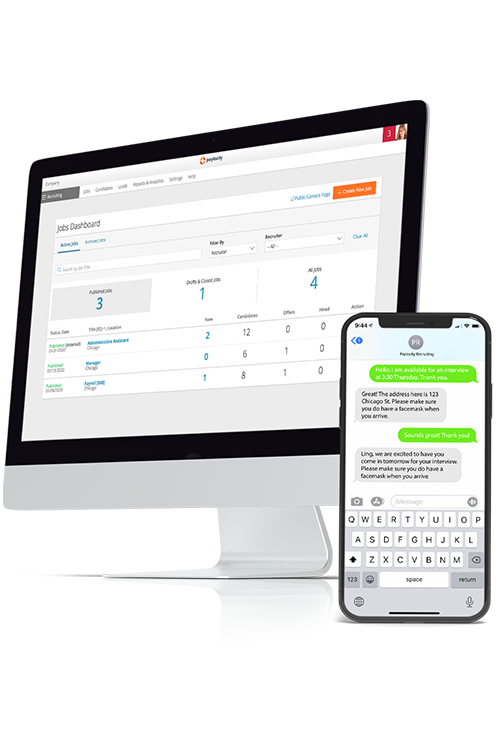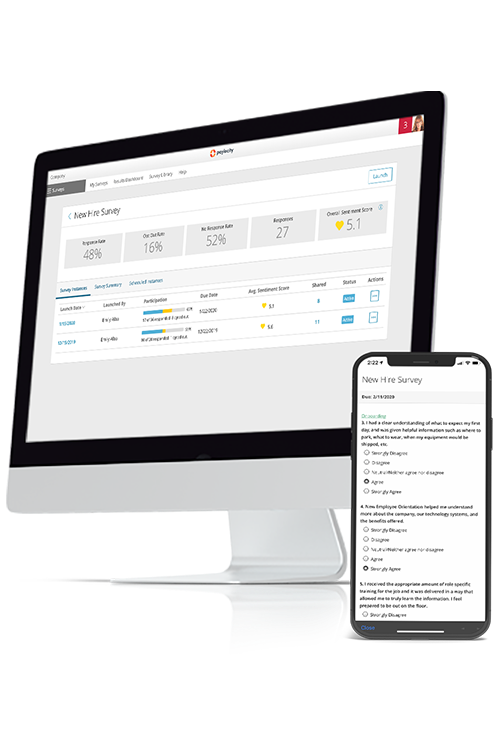resources
Your Diversity and Inclusion Strategy Needs Data
September 22, 2020
A data-driven diversity and inclusion strategy helps businesses attract, retain, and engage employees and boost productivity and profitability.
Blog Post

Employees are at the core of a business and its culture, and, increasingly, the far-reaching value of a thriving culture is being revealed. Happy and healthy employees are always the end goal, but the positive business results from a workforce that feels valued and empowered are undeniable.
Daunting as it may seem for more traditional, top-down businesses, the employee-centric organization is the way of the future. According to a Deloitte survey, “94% of executives and 88% of employees believe a distinct workplace culture is important to business success.”
In fact, Gallup found that businesses scoring in the top quartile on employee engagement saw:
- 41% lower absenteeism
- 24% less turnover in high-turnover organizations
- 59% less turnover in low-turnover organizations
- 10% higher customer ratings
- 17% higher productivity
- 20% higher sales
- 21% higher profitability
Today, the value of diversity and inclusion in the workplace is at the center of conversations around culture. “We know intuitively that diversity matters. It’s also increasingly clear that it makes sense in purely business terms,” says McKinsey and Company.
They hypothesize the more diverse companies are winning the war for top talent with their employee and customer focus. That’s because diversity and inclusion strategies are no longer a “nice to have.” Candidates, employees, and clients are making decisions on who to work for and with based on these strategies. And that top talent is key to driving business value.
See More Clearly with Data
A modern HR solution should give you access to demographic data, at the very least by distinctions protected by Federal Equal Employment Opportunity (EEO) laws: race, color, religion, sex (including pregnancy, gender identity, and sexual orientation), national origin, age (40 or older), disability, or genetic information.
During our recent “Diversity and Data” webinar, Paylocity Director of Compensation, Benefits, and Talent Analytics Calvin Sun explained the value of data to organizations at any phase of a diversity and inclusion journey.
“Data is really just a way for you to better understand what’s happening, not just what has happened or what your current state in your business is. Hopefully, to a certain extent, [data] helps you [know what to] expect and predict what will happen based on the levers you pull. Because at the end of the day, you can’t drive, build, and design organizational programs — people programs — devoid of any data. You’re literally guessing in the dark.”
It’s likely you already have a good sense of where you are on your diversity and inclusion journey, but as with any goal, if you’re going to make progress, it’s important that you test your assumptions with data and make it a priority to keep measuring. Gaining clear insight into where your organization stands today helps you to more effectively plan a path to reach your diversity and inclusion goals.
Quick Tip: Be Progressive but Not Intrusive
Your HR team will want to keep a few things in mind as you begin to dig into and collect data related to diversity and inclusion, particularly when it comes to privacy. As essential as access to data is to building an effective strategy, remember that benefit data, whether virtual or paper-based, is protected employee information. You’ll want to take extra care to keep your benefit data and your workforce demographic data separate so that there is no risk of benefits being impacted by this information.
Many HR platforms may allow for custom fields, for example, but this is a key area where risk can be introduced unnecessarily. Manage permissions and access to information closely to keep employee information private.
Who’s Coming, Who’s Going, and Who’s Staying
When it comes to transforming the makeup of your workforce, no matter how big or small that transformation, one of the most effective places to start is by looking at your incoming and outgoing talent. The rate at which you’re hiring and separating from employees of diverse groups gives you a sense of where your workforce is heading and lets you know where you can focus your efforts. As an HR leader, you maintain an organization-wide perspective, but you can partner with your leaders with cascading diversity and inclusion goals.
Work with your leaders and hiring managers on their recruiting sources and job descriptions to help ensure diverse candidate pools. Though not all candidates will self-identify all these different demographic categories, being intentional about your candidate pool is impactful.
For example, consider the finding from a Hewlett Packard internal report that Sheryl Sandberg and other authors on the topic of women in the workforce cite often: “Men apply for a job when they meet only 60% of the qualifications, but women apply only if they meet 100% of them.” Take a close look at your job descriptions and remove any requirements that aren’t truly necessary and might be keeping an otherwise qualified candidate from applying.
Consider whether the job boards you’re posting to and career fairs you’re attending are helping you reach diverse audiences. Be intentional about building a pipeline of candidates that reflects the diversity you want to see in your own workforce and be mindful of asking candidates consistent questions that will truly help you assess qualifications without bias.
Of course, you want to partner these recruiting strategies with close monitoring of turnover. It’s no secret that the cost of turnover is high, in the ballpark of $15,000 per worker or 33% of their annual salary. But if you’re losing employees who bring diversity to your company at a faster rate, it could indicate what Cornell University calls a “climate concern” in their response to why turnover rates matter.
To dig into why you might be losing diverse talent, evaluate whether your employees are being provided equal opportunities, from career development to pay and promotions — especially to leadership positions.
Prioritizing diversity and inclusion in your recruitment and retention strategies is not about appointing specific groups to specific roles but instead about creating an equitable environment where you’re conscious and intentional in those areas. Making your organization an attractive place for employees to come is important, but an environment that welcomes and nurtures a diverse workforce that wants to stay shows you’re really doing something right.
Start Small with Transparency and Connection
Common advice for companies trying to change their corporate culture is to understand and accept that the transformation won’t happen overnight. “We’ve found that managers get better results when they start with a few smaller successes, which then provide a basis for expanding,” according to the Harvard Business Review.
And before you take any steps, Calvin recommends that you confirm your plans by surveying or polling your employees. “If you really want to keep your finger on the pulse of the organization, you need these quick hits [...] This just-in-time dialogue has been immensely helpful for us.”
Understanding your representation data is a key starting place on your diversity and inclusion journey. Remember that the data represents people, and people are engaged, motivated, and retained when they feel valued, seen, heard, respected, and understood. A great way to do this is by gathering feedback and encouraging dialogue to help stay in tune with how your diversity and inclusion strategy is connecting with your employees.
The boost in creativity and problem-solving that a diverse and inclusive workplace experiences not only increases employee engagement and retention, but ultimately, companies are reporting higher profitability and productivity as well.
The health of any business hinges on its ability to attract and retain top talent and maintain a strong reputation among both employees and customers. To make progress on your own diversity and inclusion strategy, data support your best intentions and help you reach your goals. Find more diversity, equity, and inclusion tips in our resource library.
At Paylocity, we believe diversity and inclusion make us stronger partners to our clients by helping us deliver a stronger product. Learn more about where we are and what we’re doing.





